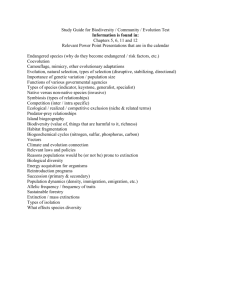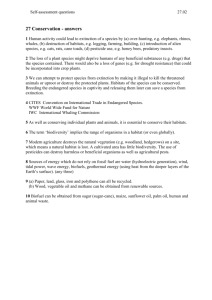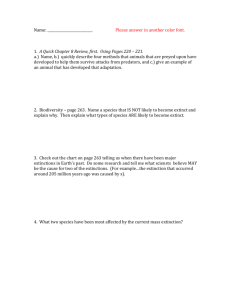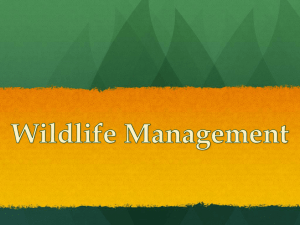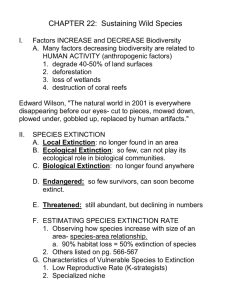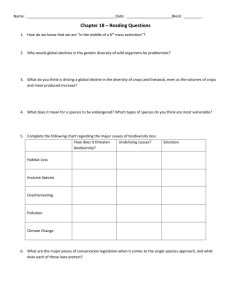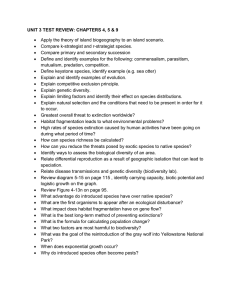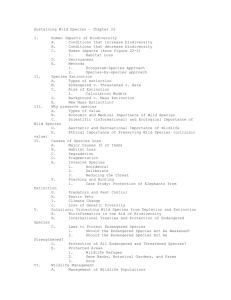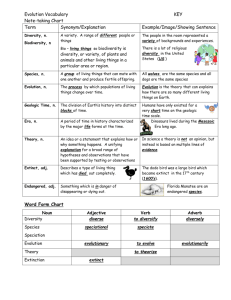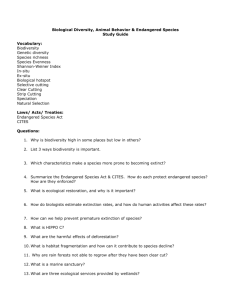chapter9
advertisement
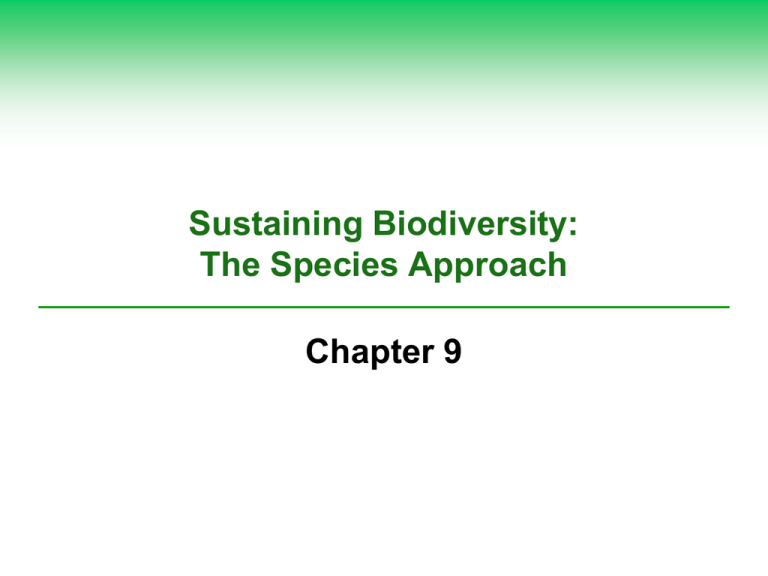
Sustaining Biodiversity: The Species Approach Chapter 9 9-1 What Role Do Humans Play in the Premature Extinction of Species? Concept 9-1A We are degrading and destroying biodiversity in many parts of the world, and these threats are increasing. Concept 9-1B Species are becoming extinct 100 to 1,000 times faster than they were before modern humans arrived on the earth (the background rate), and by the end of this century, the extinction rate is expected to be 10,000 times the background rate. Human Activities Are Destroying and Degrading Biodiversity Human activity has disturbed at least half of the earth’s land surface • Fills in wetlands • Converts grasslands and forests to crop fields and urban areas Degraded aquatic biodiversity SPECIES EXTINCTION Species can become extinct: • Locally: A species is no longer found in an area it once inhabited but is still found elsewhere in the world. • Ecologically: Occurs when so few members of a species are left they no longer play its ecological role. • Globally (biologically): Species is no longer found on the earth. Some Human Activities Cause Premature Extinctions; the Pace Is Speeding Up Conservative estimates of extinction = 0.011.0% • Growth of human population will increase this loss • Rates are higher where there are more endangered species • Tropical forests and coral reefs, wetlands and estuaries—sites of new species—being destroyed HABITAT LOSS, DEGRADATION, AND FRAGMENTATION Figure 9-10 The greatest threat to a species is the loss, degradation, and fragmentation of where it lives. Number of species existing Effects of a 0.1% extinction rate 5 million 5,000 extinct per year 14 million 50 million 100 million 0 14,000 extinct per year 50,000 extinct per year 100,000 extinct per year 50 100 150 Number of years until one million species are extinct 200 Fig. 9-3, p. 186 Endangered Natural Capital: Species Threatened with Premature Extinction Fig 9-4 Characteristic Examples Low reproductive rate (K-strategist) Blue whale, giant panda, rhinoceros Specialized niche Narrow distribution Blue whale, giant panda, Everglades kite Elephant seal, desert pupfish Feeds at high trophic level Bengal tiger, bald eagle, grizzly bear Fixed migratory patterns Rare Commercially valuable Large territories Blue whale, whooping crane, sea turtle African violet, some orchids Snow leopard, tiger, elephant, rhinoceros, rare plants and birds California condor, grizzly bear, Florida panther Stepped Art Fig. 9-5, p. 188 Percentage of Various Species Threatened with Premature Extinction Fig 9-6 Science Focus: Estimating Extinction Rates Is Not Easy Three problems • Hard to document due to length of time • Only 1.8 million species identified • Little known about nature and ecological roles of species identified 9-2 Why Should We Care about Preventing Premature Species Extinction? Concept 9-2 We should prevent the premature extinction of wild species because of the economic and ecological services they provide and because they have a right to exist regardless of their usefulness to us. Why Should We Care About Biodiversity? • • • • • • • • • Aesthetic pleasure Ecological: (environmental monitor, ecological balance – keystone species) Educational Historical or cultural Natural Services: (air and water purification, soil fertility, waste disposal,) Recreational Medicine Agriculture: (biological pest control, food source, commercial product – wood) Moral or ethics Natural Capital: Nature’s Pharmacy Fig 9-8 Endangered Scarlet Macaw is a Source of Beauty and Pleasure 9-3 How do Humans Accelerate Species Extinction? Concept 9-3 The greatest threats to any species are (in order) loss or degradation of its habitat, harmful invasive species, human population growth, pollution, climate change, and overexploitation. Loss of Habitat Is the Single Greatest Threat to Species: Remember HIPPCO Habitat destruction, degradation, and fragmentation Invasive (nonnative) species Population and resource use growth Pollution Climate change Overexploitation NATURAL CAPITAL DEGRADATION Causes of Depletion and Premature Extinction of Wild Species Underlying Causes • Population growth • Rising resource use • Undervaluing natural capital • Poverty Direct Causes • Habitat loss • Pollution • Commercial hunting and poaching • Habitat degradation and fragmentation • Introduction of nonnative species • Climate change • Sale of exotic pets and decorative plants • Overfishing • Predator and pest control Fig. 9-10, p. 193 Animation: Humans affect biodiversity Click for animation Natural Capital Degradation: Reduction in the Ranges of Four Wildlife Species Fig 9-11 Case Study: A Disturbing Message from the Birds (1) Habitat loss and fragmentation of the birds’ breeding habitats • Forests cleared for farms, lumber plantations, roads, and development Intentional or accidental introduction of nonnative species • Eat the birds Case Study: A Disturbing Message from the Birds (2) Seabirds caught and drown in fishing equipment Migrating birds fly into power lines, communication towers, and skyscrapers Other threats • • • • Oil spills Pesticides Herbicides Ingestion of toxic lead shotgun pellets Distribution of Bird Species in North America and Latin America Fig 9-12 The Ten Most Threatened Song Birds in the United States Fig 9-13 Some Deliberately Introduced Species Can Disrupt Ecosystems Most species introductions are beneficial • • • • Food Shelter Medicine Aesthetic enjoyment Nonnative species may have no natural • • • • Predators Competitors Parasites Pathogens Fig. 9-14a, p. 199 Fig. 9-14b, p. 199 Argentina Fire Ant Accidentally Introduced into Mobile, Alabama, U.S. Fig 9-11 Quagga and Zebra Mussels in California Quagga fact sheet INVASIVE SPECIES Many nonnative species provide us with food, medicine, and other benefits but a a few can wipe out native species, disrupt ecosystems, and cause large economic losses. Arundo removal in the Santa Clara River Watershed Click for Aurndo report Negative Impacts of Arundo • Reduction in the shading of surface water, resulting in increased water temperatures and decreased dissolved-oxygen content, which has a negative impact on native wildlife • Reduction in groundwater availability through rapid transpiration • Alterations in channel morphology by retaining sediments and constricting flows • Increased bank erosion due to the diversion of water around established stands • Displacement of riparian habitat through monopolization of soil moisture • Displacement of riparian habitat due to establishment dense monocultures of arundo • Reduction in the food supply (particularly insects) of riparian-dependent wildlife • Reduction of wildlife utilization of an infested area • Increased probability of wildfire occurrences, intensity, and area from increased fire fuel loads Prevention Is the Best Way to Reduce Threats from Invasive Species Prevent them from becoming established Learn the characteristics of the species Set up research programs Try to find natural ways to control them Characteristics of Invader Species and Ecosystems Vulnerable to Invading Species Fig 9-17 What Can You Do? Controlling Invasive Species Fig 9-18 Bioaccumulation and Biomagnification Fig 9-19 Confiscated Products Made from Endangered Species Illegal Killing, Capturing, and Selling of Wild Species Threatens Biodiversity Poaching and smuggling of animals and plants • Animal parts • Pets • Plants for landscaping and enjoyment Prevention: research and education 9-4 How Can We Protect Wild Species from Premature Extinction? (1) Concept 9-4A We can use existing environmental laws and treaties and work to enact new laws designed to prevent species extinction and protect overall biodiversity. Concept 9-4B We can help to prevent species extinction by creating and maintaining wildlife refuges, gene banks, botanical gardens, zoos, and aquariums. 9-4 How Can We Protect Wild Species from Premature Extinction? (2) Concept 9-4C According to the precautionary principle, we should take measures to prevent or reduce harm to the environment and to human health, even if some of the cause-andeffect relationships have not been fully established, scientifically. International Treaties Help to Protect Species 1975: Convention on International Trade in Endangered Species (CITES) • Signed by 172 countries Click for link to CITES Convention on Biological Diversity (BCD) • Focuses on ecosystems • Ratified by 190 countries (not the U.S.) Click for link to BCD SPECIES EXTINCTION Scientists use measurements and models to estimate extinction rates. • The International Union for the Conservation of Nature and Natural Resources (IUCN) publishes an annual Red List, listing the world’s threatened species. • There are now 47,667 species on the IUCN Red List (2009 data) and 17,291 of them are threatened with extinction, up from 16,118 last year. IUCN web page Figure 11-5 Case Study: The U.S. Endangered Species Act (1) Endangered Species Act (ESA): 1973 and later amended in 1982, 1983, and 1985 Identify and protect endangered species in the U.S. and abroad Hot Spots Case Study: The U.S. Endangered Species Act Fig 10-27 Biodiversity hotspots in relation to the largest concentrations of rare and potentially endangered species in the U.S. Science Focus: Accomplishments of the Endangered Species Act (1) Species listed only when serious danger of extinction Takes decades for most species to become endangered or extinct More than half of the species listed are stable or improving Budget has been small Science Focus: Accomplishments of the Endangered Species Act (2) Suggested changes to ESA • Increase the budget • Develop recovery plans more quickly • Establish a core of the endangered organism’s survival habitat Click for US Fish and Wildlife Service PROTECTING WILD SPECIES: THE SANCTUARY APPROACH The U.S. has set aside 544 federal refuges for wildlife, but many refuges are suffering from environmental degradation. Pelican Island was the nation’s first wildlife refuge. We Can Establish Wildlife Refuges and Other Protected Areas 1903: Theodore Roosevelt Wildlife refuges • Most are wetland sanctuaries • More needed for endangered plants • Could abandoned military lands be used for wildlife habitats? Gene Banks, Botanical Gardens, and Wildlife Farms Can Help Protect Species Gene or seed banks • Preserve genetic material of endangered plants Botanical gardens and arboreta • Living plants Farms to raise organisms for commercial sale Zoos and Aquariums Can Protect Some Species (1) Techniques for preserving endangered terrestrial species • • • • • • Egg pulling Captive breeding Artificial insemination Embryo transfer Use of incubators Cross-fostering Zoos and Aquariums Can Protect Some Species (2) Limited space and funds Critics say these facilities are prisons for the organisms What Can You Do? Protecting Species Fig 9-24 RECONCILIATION ECOLOGY Reconciliation ecology involves finding ways to share places we dominate with other species. • Replacing monoculture grasses with native species. • Maintaining habitats for insect eating bats can keep down unwanted insects. • Reduction and elimination of pesticides to protect non-target organisms (such as vital insect pollinators). The Precautionary Principle Species: primary components of biodiversity Preservation of species Preservation of ecosystems Animation: Humans affect biodiversity Click for animation
